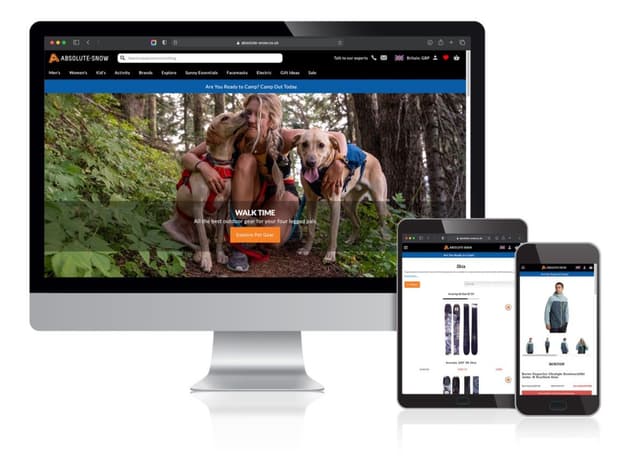Ecommerce Platform Battles: BigCommerce vs Remarkable Commerce
A retailers technology stack choice will set the path for their digital performance, so choosing wrongly can be truly disastrous. Yet re-platforming is a huge undertaking for any retailer and should not be underestimated, however, it is commonly a requirement for growth – as many retailers will see small (or even negative) growth year-on-year, and will have hit the ceiling of capabilities of their current platforms.
As one of the most popular, fastest-growing commerce platforms in the market today, BigCommerce is often one of the most popular choices when reviewing eCommerce platform providers - particularly for retailers smaller than £5m p/a,
Also, BigCommerce is certainly stronger for B2B eCommerce than Shopify.
Truth is, some of the largest retailers in the UK use these platforms to power their retail experiences – but the question remains, how much potential is being left on the table because of the known limitations.
So, what are the core differences and comparisons between these platforms? Below we review the most common features and popular questions.
1. Cost of ownership
Remarkable Commerce: The Remarkable Commerce platform is fully tailored for each retailer and therefore is not an ‘off the shelf SaaS’ product as its competitors are. The license fee is simply based on average monthly sessions, with tiered price bands – there are no GMV/commission fees. Build costs start at £50,000. The license fee covers unlimited use of the Remarkable Commerce platform for an unlimited number of admin’ users, unlimited amount of API calls and several product variations, telephone and email technical support during office hours, server maintenance, database maintenance, error log maintenance, third-party maintenance and browser maintenance.
BigCommerce: BigCommerce entry-level options depend on the value of online sales; BigCommerce Standard, BigCommerce Plus and BigCommerce Pro are available. All have 0% transaction fees. BigCommerce Enterprise licenses are based on order volume and gross merchandise value (GMV), and for a £20m p/a retailer, a license will be roughly £2k per month. Your license fee simply grants access to the platform. Build costs for larger sites typically range between £60,000 and £150,000, depending on requirements. Development/agency work is an additional cost to this.
2. Market sector
Remarkable Commerce is tailored primarily towards enterprise-level retailers seeking fully customized and high-performance solutions. Its core appeal lies in flexibility and bespoke development—offering custom-built, scalable platforms that are ideal for businesses with unique requirements, often in fashion, lifestyle, and omnichannel retail. Remarkable typically targets brands that require deep integration with legacy systems, custom workflows, and complete control over the frontend and backend experience. Its clients often have in-house teams or agency support to manage and evolve complex commerce needs.
In contrast, BigCommerce serves a broader spectrum of businesses, from small to mid-sized to large enterprises, with a strong emphasis on ease of use, rapid deployment, and out-of-the-box features. As a SaaS solution, BigCommerce provides robust tools, built-in integrations, and scalability without the need for heavy custom development. It is especially popular among merchants seeking cost-effective solutions with strong multichannel capabilities (e.g., Amazon, eBay, social commerce).
In essence, Remarkable Commerce is positioned for enterprise retailers demanding tailored solutions, while BigCommerce caters to a wider audience, especially smaller businesses looking for less flexibility and have little complexity.
3. Integration partnerships
Remarkable Commerce: The Remarkable Commerce platform has over 300 integrated solutions, covering a wide range of technology types. Although the integrations are not self-serving in the admin, all historic integrations are fairly plug-and-play and available with a short amount of development time. https://remarkable.net/integrations/ the full list of integrations, updated annually.
BigCommerce: If the standard set of features provided by BigCommerce isn’t sufficient for your needs, then you might want to consider purchasing some apps from its App Store. A fairly wide range of integrations is available in the app store, which let you add many additional features to your BigCommerce storefront. Their App Store has grown quickly, however, the biggest downside of plugins is their extreme lack of customisation ability. Secondly, individual apps/plugins struggle to connect – meaning there is a large reliance on additional connectors, or in some cases, no ability to connect incredibly important data.
4. APIs and architecture
Remarkable Commerce: True innovation and development agility is possible when your eCommerce platform can be integrated with any solution and data can be accessed in real-time both manually and dynamically – this is why an open API is critical and is why Remarkable Commerce has a suite of APIs which can be used in a headless fashion to retrieve and post data to. Headless architecture and simple, API integrations give you the flexibility to engage customers across every retail touchpoint – web, mobile, apps, marketplaces, in-store – and deliver seamless omnichannel experiences. Remarkable Commerce has a pre-integrated front end accelerator that slashes ‘time to web’ for new digital storefronts, so you can focus on UX, brand strategy and optimisation.
BigCommerce: 90% of platform data is exposed to APIs, and allows for 400+ API calls per second – however, data access is only useful if configuration optimisations can be made, to improve performance. Unfortunately, many fundamental areas are non-editable – e.g. canonical URLs cannot be customized in a Bigcommerce site. Additionally, Meta field data can only be edited by the API user that created the data. Meta field data is the only data where the API applies this restriction and is a very common issue. Another large architecture issue for BigCommerce retailers is the lack of ability for creating automated attribute-driven categories, therefore manual and time-consuming attribute mapping is required.

5. Product & catalogue management
Remarkable Commerce: With an endlessly customisable admin (and storefront!), all Remarkable Commerce platform clients have heavily tailored functionality which saves them time and effort, when managing large amounts of products and categories. A few popular features inside the PIM module of Remarkable Commerce include a product translations interface: allowing the retailer to bulk set translated copy
BigCommerce: Instead of having its own dedicated admin area, inventory is accessed via each product screen (same as Shopify). It’s not a major disadvantage, but if you deal with a large number of items with high turnover, like a fast-fashion retailer, it will definitely reduce your productivity. However, you can set up flexible product inventory rules.
Without having automatic categorisation tools, it’s very common for stores with a large number of products to keep discontinued items listed, or products misclassified if using categories like “On Sale”, “New Releases”, “Best Sellers” or similar. If visitors browsing your site constantly run into the wrong type of products or products that are not available, they’ll get frustrated and assume your entire website is not been kept up to date. If you have access to automated or smart categorization tools, use these to automatically assign products to categories and sub-categories based on their attributes.
6. Order management
Remarkable Commerce: The OMS module in the Remarkable Commerce platform has many customisable fields and functions, with the base solution including Bulk Orders Management, Returns and Refunds Management, Custom Order tagging, Management of Order status emails, Bespoke Invoicing, Automated Courier Tracking, Automated Payment Tracking, Manual Order (MOTO) functions for Customer Service teams and a full suite of advanced reporting.
BigCommerce: Heavily reliant on 3rd party apps like Brightpearl and ShipperHQ, which are shipping/courier management solutions that allow retailers to set up rates/rules themselves. However, there is key functionality that is not achievable – such as custom logic for dynamically identifying and flagging particular items that should be pre-order applicable, based on product data rules.
7. Extensibility and flexibility
Remarkable Commerce: One of the biggest USPs of Remarkable Commerce is how extendable the platform is. This is achievable because each retailer who uses the Remarkable Commerce Platform has a tailored version of the storefront, that is connected through APIs, to their fully-custom admin/control panel. Both the frontend and the admin are commonly extended to include additional modules, functions and connectors. With full access to every line of architecture code, the Remarkable Commerce agency team have no limitations or restrictions, leading to infinitely customisable customer experiences.
BigCommerce: When comparing all eCommerce platforms on the market, BigCommerce is one of the few which has an adequate level of extendable. They use plugins and 3rd party applications (or through their SDK if your wish to extend the Checkout), to achieve the vast amount of retailer requests. BigCommerce has understood that the future of eCommerce is not a closed ecosystem and that building every possible feature into the core platform and then putting a wall around it is a strategy that’s short-sighted. Instead, they focus on building strong robust core functions like catalogue management and customer management – with a reasonable amount of APIs.
8. Admin Ease of Use
Remarkable Commerce: The Remarkable Commerce Manager (admin portal) has been moulded over the last 20+ years, with the direction and direct input from clients of various sizes – this has led to a comprehensive and easy to use platform, where a retailer can complete key actions much quicker than other platforms. An example of this is promotion/campaign setup and launching, which can be achieved within minutes. Each client has a tailored version of the core admin where they request function and UX updates – ultimately leading the development roadmap for their own version.
BigCommerce: Being a true SaaS solution, the BigCommerce admin/control panel is the same for every retailer who uses it. The only difference is custom fields or any ‘apps’ installed into that area of the admin. This rigidity means the development of the admin is slow and too restrict for agile retailers relying on responsive trading.
9. SEO (Search Engine Optimisation)
Remarkable Commerce: Remarkable Commerce is a totally bespoke platform so the admin can be tailored to suit your needs within the build phase. Due to it being flexible, it allows for custom rules and logic to be created to automate certain features that influence SEO, such as a product retirement strategy. It doesn’t, however, have plugins and any mar-tech integration would be actioned as a development project.
BigCommerce: BigCommerce offers a good CMS to update all on-page SEO elements within a website. It also allows you to stay on top of technical SEO elements such as redirects, mobile optimisation, schema and hierarchy. It has a small library of plugins that can be used to influence other areas of SEO but does not offer flexibility apart from what is offered natively via the platform or the plugins.
10. Roadmap
Remarkable Commerce: Each retailer who uses the Remarkable Commerce Platform has their own unique roadmap of storefront and admin new functionality, change requests and version updates. This enables every retailer to take their own direction but also benefit from the larger frequent platform updates that every client receives.
BigCommerce: Although BigCommerce focuses a large amount of time on their ‘community hub’, where BC users can submit ideas and ask questions, the reality is that plugins and 3rd party apps are heavily relied on to deliver key operating functionality. The BigCommerce admin has not seen many function changes, instead BigCommerce focus on enhancing their storefront API (which is powered by GraphQL), so that developers can build headless experiences themselves (web stores, native app stores, custom PWA stores).

11. Internationalisation
Remarkable Commerce: Retailers need the ability to change, adapt and launch as quickly as possible, without needing to repeat tasks. This is the reason that we created functionality for retailers to launch promotions across multiple sites, apply configuration updates to multiple sites and publish content updates to selected sites in real-time. Removing restrictions, improving efficiencies and enabling revenue growth.
BigCommerce: The BC multi-currency features are available on all version/plans and was recently overhauled, however, the translation functionality is severally lacking – which makes international payments extremely less likely. Almost every BigCommerce theme/template is created with an English language set, and configuring language settings are labour intensive.
12. Storefront Speed, Performance and UX
Remarkable Commerce: With an obsession with site speed and storefront performance, the frontend developers at Remarkable Commerce pay particular attention to speed metrics and regularly undertake speed audits, to review what area of code can be optimised further. This continuous exercise ensures that our clients are providing the very best customer experience and quickest sites possible.
BigCommerce: The BigCommerce theme engine is named Stencil and incorporates industry best practices, however, can be likened to an oil tanker – which takes a very long time to move direction and generally improve. As a recent example, although the AMP (accelerated mobile pages) page type is not being fully endorsed and pushed by Google engineers – yet BigCommerce actively recommend the enablement of this page type.
Conclusion
The question of what eCommerce platform to use (or migrate to) is always a really tough decision for any business to make, especially when the retailer has a turnover above £50m p/a – as there is a lot more budget at stake, more stakeholders involved etc. Enterprise eCommerce solutions don’t come cheap and they require a huge amount of time (and a lot of people) to implement, run and maintain. This is why it’s incredibly important that you remain highly organised and systematic in your research and decision-making process, as selecting the wrong platform can have a huge impact on your business.
Ultimately, a retailers platform choice should be in line with both their current online performance and their growth ambitions. There are many pros and cons for BigCommerce, and where one excels, the other underperforms. For retailers with a turnover above £5m p/a and considering a platform switch, check out https://remarkable.net/commerce-platform/ to learn more about the Remarkable Commerce Platform.

















